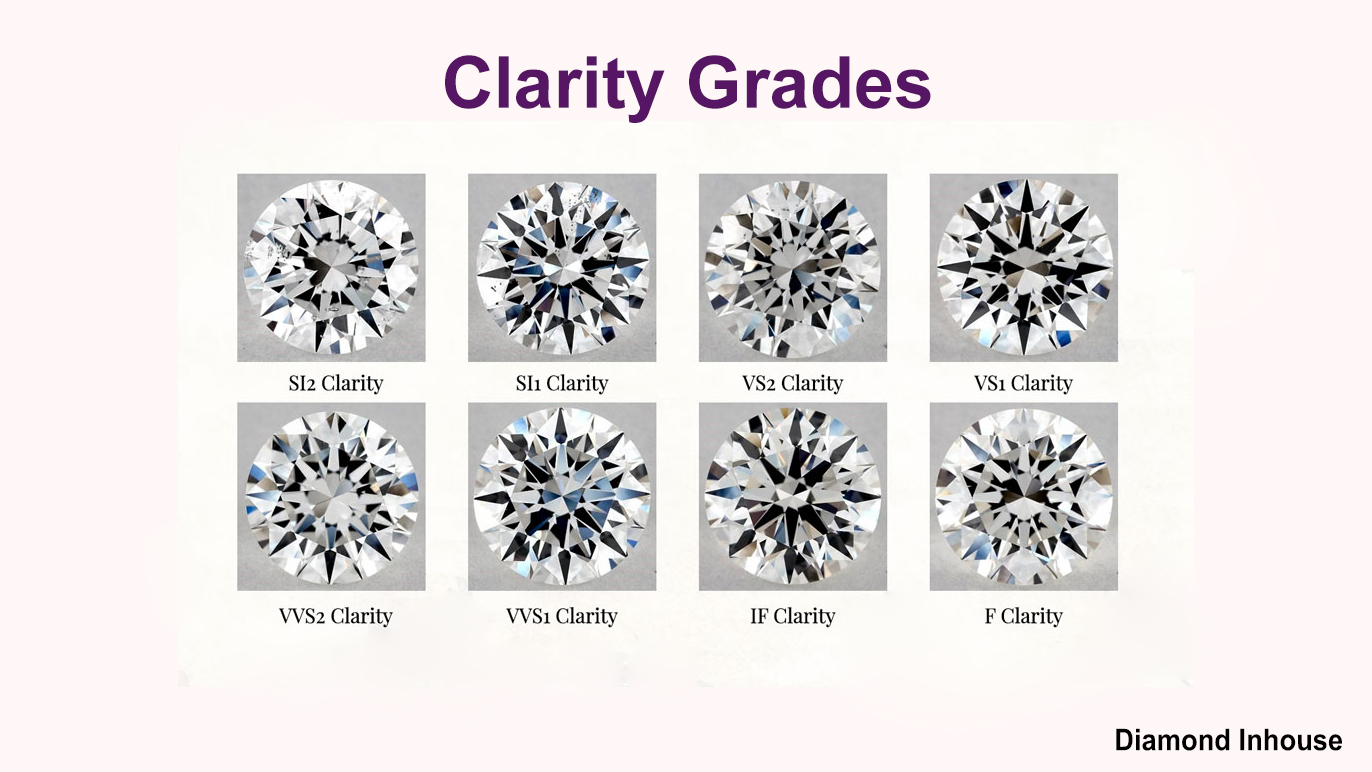Do you know why understanding Diamond Clarity is important?
Diamond clarity is the evaluation of flaws and imperfections on the surface and within the Diamond. In simple terms, the Clarity shows the degree of the defectiveness which are presented in the diamonds. The flaws which are outside i.e. on the surface are called blemishes, While the defects which are inside, or which are internal are called inclusions. For selecting the perfect diamond, you should know the diamond clarity chart. The down below shows the diamond Clarity chart.

Diamonds that contain a greater number of inclusions or blemishes have definitely had a lesser brilliance than the one; lesser or not having any inclusions. As the diamond will not show sparkle if the inclusion is more because of the flaws which interfere with the path of light.
Diamonds are not perfect but are unique in nature
Basically, Diamonds are graded using the 11 different categories of clarity chart or scale which is created by the GIA. So, we will try to make it as simple as possible for you to understand the clarity grades easily.
So, let’s understand what are the different Diamond Clarity chart grades.
CLARITY GRADES
FLAWLESS (F)
It is also known as FL grade in short. Flawless diamond shows no inclusions or blemishes of any kind, which means the diamond is 100% flawless. It can be examined under a 10X magnification by a professional or skilled grader.
INTERNALLY FLAWLESS (IF)
Internally flawless diamond shows only insignificant blemishes and no inclusions (IF). It is nearly impossible to see any blemishes from the naked eyes. Even a trained professional might get it wrong when FL and IF diamonds are compared.
VERY VERY SLIGHTLY INCLUDED (VVS 1 AND VVS 2)
VVS 1 and VVS 2 diamonds are nearly perfect with almost no visible inclusions. Generally, there are two types of grades with the VVS category like VVS 1 and VVS 2 which indicates the size and the spot of the flaws. The VVS 1 stands above VVS 2 with subject to Clarity. As a comparison, VVS1 diamonds have one or two imperfections that are not on the table, which means they are off-centered whereas VVS2 can have a bit more imperfections that are closer to the center. The more imperfection on the center of the diamond which will hurt the sparkling light. The diamond with the grades of VVS 1 is a bit costlier than the one with the VVS 2 grades.
VERY SLIGHTLY INCLUDED (VS 1 AND VS 2)
The diamond which is graded in VS 1 and VS 2, has a small inclusion that is very difficult to identify with the naked eyes but can be read and seen with the 10x magnification by the professionals. The difference between the 2 grades: In VS 1, the flaws are not visible with your bare eyes whereas in VS 2 the flaws can be visible with the diamond tools and can be seen by the naked eyes when compared with the larger diamonds like 1.5 carats, 2 carats. The flaws are very small which can be located near the table and sides of the diamond near the girdle. According to our knowledge, these are the most preferred and purchased categories across the world.
Slightly Included (SI 1 and SI 2)
The diamond which is graded in the Slightly Included category contains the noticeable inclusions under the 10x magnifications. The buying decision for the SI category diamonds can be a tricky task. Many people end up buying the wrong diamond. Like the previous categories, this category comes in 2 grades SI 1 and SI 2. The inclusions are visible at the very first look under the 10x magnifications that comes under the SI 1 grades, and the diamonds with the SI 2 grades have more flaws than the SI 1 and can be located more frequently on the diamonds. The advantage of buying this grade diamonds is the lower prices which these grade diamonds are offering. For this category, we are suggesting, you can ask for the diamonds which don’t have any defects in the center i.e. the table part.
Included (I1, I2, and I3)
The diamond under the category of Included can affect the transparency and look of the diamond. The flaws and defects are way more in this category. The flaws can be seen from the naked eyes. As the grades go down i.e. from I1 to I2 to I3, the flaws and defects in the diamond will increase and will damage the looking, transparency, and sparkle of the diamond. The I1 grade can be said to be the last grade where we can find an eye-clean diamond not wholly but with the clean center. The I2 and I3 grades will be full of flaws and defects and it will be very difficult to find the eye clean diamond. So, this category should be purchased with the advice of some experts and only with the proper diamond certifications.
Conclusion
However, these were the diamond clarity chart grading category which is followed by many laboratories and this information will help you in your buying decision of diamonds for any kind of jewelry.
If you want to read and understand the buying guidelines then you can browse here: The Buying Guide.

